An Economic Analysis of Cigarette Price Changes and Consumer Demand
VerifiedAdded on 2023/01/23
|11
|3053
|33
Report
AI Summary
This report provides an economic analysis of cigarette price changes and their effects on consumer demand. The introduction defines cigarettes and highlights their addictive nature and the role of governments in minimizing consumption through policies that influence demand. The discussion section explores economic theory, using global and country-specific data to demonstrate the inverse relationship between cigarette prices and consumption. It uses the United States as a case study, showing a decline in cigarette consumption from 2000 to 2015, attributed to increased excise taxes and rising prices. The report also examines price elasticity of demand, comparing the responses of different population groups, such as teenagers and adults, to price changes. Furthermore, the report suggests various policies, including increased taxes, health insurance premiums, and restrictions on smoking zones, to regulate cigarette consumption and mitigate its harmful health effects. The conclusion reiterates the negative health impacts of tobacco products, emphasizing the role of economic theory in informing policies aimed at reducing cigarette consumption and saving lives.
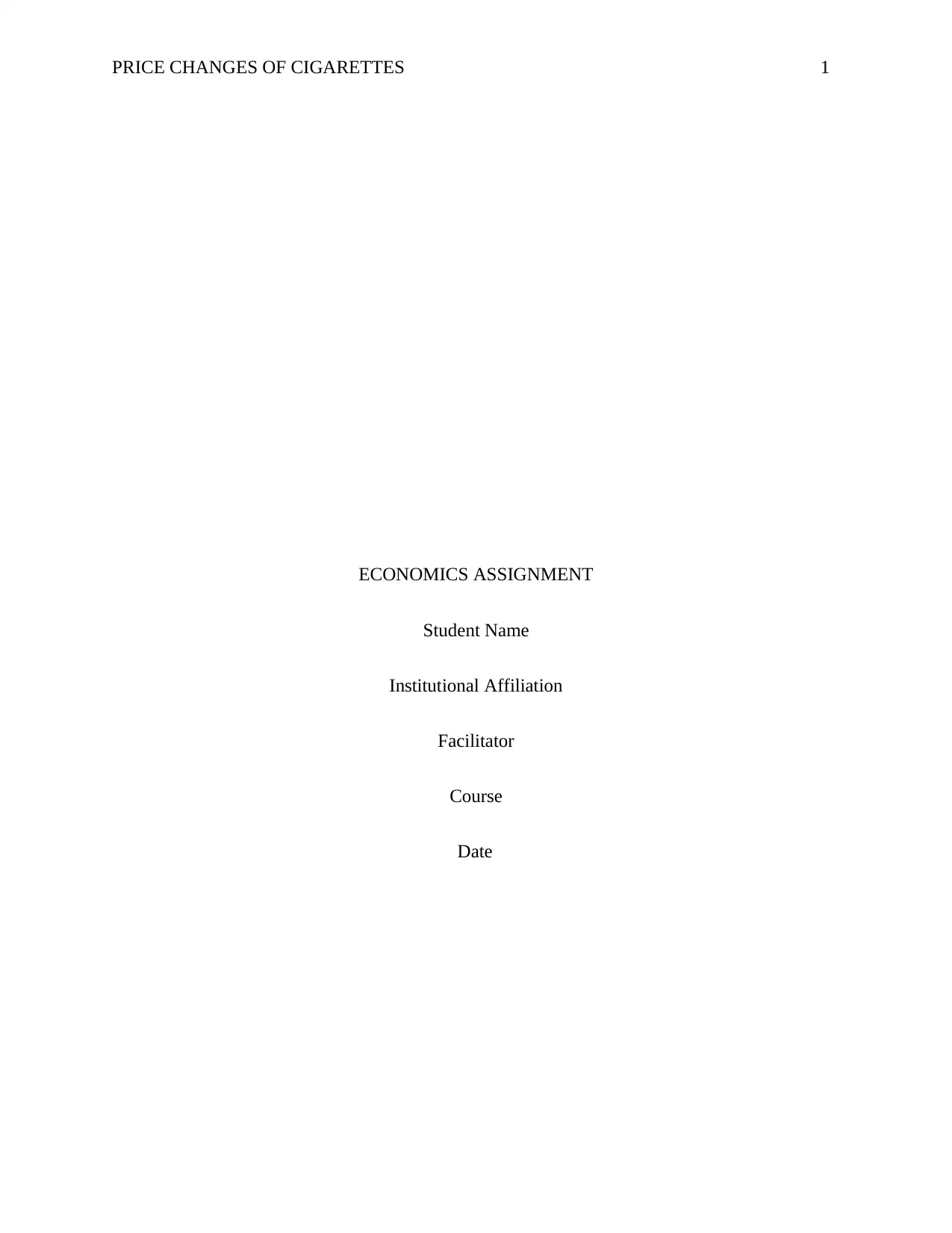
PRICE CHANGES OF CIGARETTES 1
ECONOMICS ASSIGNMENT
Student Name
Institutional Affiliation
Facilitator
Course
Date
ECONOMICS ASSIGNMENT
Student Name
Institutional Affiliation
Facilitator
Course
Date
Paraphrase This Document
Need a fresh take? Get an instant paraphrase of this document with our AI Paraphraser
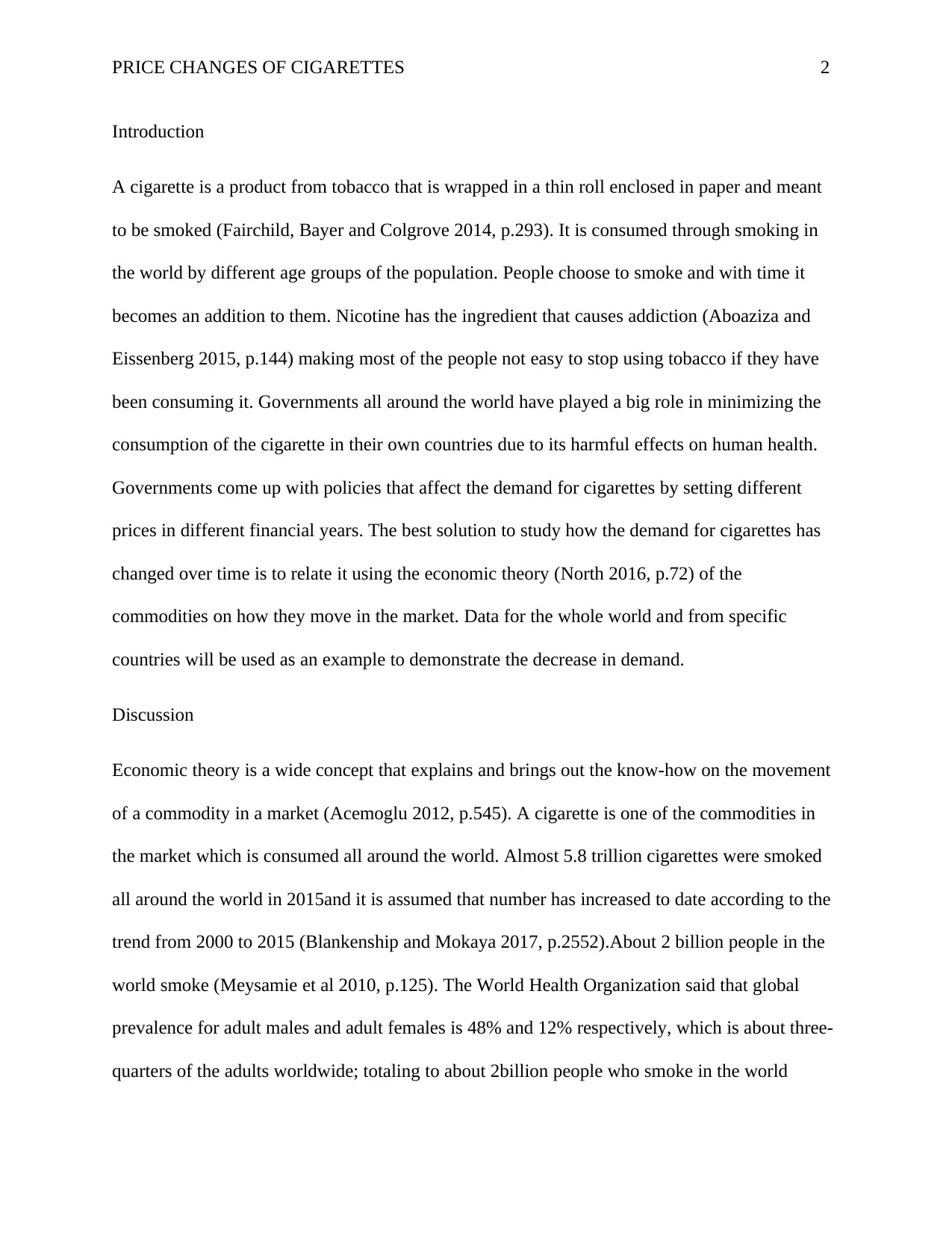
PRICE CHANGES OF CIGARETTES 2
Introduction
A cigarette is a product from tobacco that is wrapped in a thin roll enclosed in paper and meant
to be smoked (Fairchild, Bayer and Colgrove 2014, p.293). It is consumed through smoking in
the world by different age groups of the population. People choose to smoke and with time it
becomes an addition to them. Nicotine has the ingredient that causes addiction (Aboaziza and
Eissenberg 2015, p.144) making most of the people not easy to stop using tobacco if they have
been consuming it. Governments all around the world have played a big role in minimizing the
consumption of the cigarette in their own countries due to its harmful effects on human health.
Governments come up with policies that affect the demand for cigarettes by setting different
prices in different financial years. The best solution to study how the demand for cigarettes has
changed over time is to relate it using the economic theory (North 2016, p.72) of the
commodities on how they move in the market. Data for the whole world and from specific
countries will be used as an example to demonstrate the decrease in demand.
Discussion
Economic theory is a wide concept that explains and brings out the know-how on the movement
of a commodity in a market (Acemoglu 2012, p.545). A cigarette is one of the commodities in
the market which is consumed all around the world. Almost 5.8 trillion cigarettes were smoked
all around the world in 2015and it is assumed that number has increased to date according to the
trend from 2000 to 2015 (Blankenship and Mokaya 2017, p.2552).About 2 billion people in the
world smoke (Meysamie et al 2010, p.125). The World Health Organization said that global
prevalence for adult males and adult females is 48% and 12% respectively, which is about three-
quarters of the adults worldwide; totaling to about 2billion people who smoke in the world
Introduction
A cigarette is a product from tobacco that is wrapped in a thin roll enclosed in paper and meant
to be smoked (Fairchild, Bayer and Colgrove 2014, p.293). It is consumed through smoking in
the world by different age groups of the population. People choose to smoke and with time it
becomes an addition to them. Nicotine has the ingredient that causes addiction (Aboaziza and
Eissenberg 2015, p.144) making most of the people not easy to stop using tobacco if they have
been consuming it. Governments all around the world have played a big role in minimizing the
consumption of the cigarette in their own countries due to its harmful effects on human health.
Governments come up with policies that affect the demand for cigarettes by setting different
prices in different financial years. The best solution to study how the demand for cigarettes has
changed over time is to relate it using the economic theory (North 2016, p.72) of the
commodities on how they move in the market. Data for the whole world and from specific
countries will be used as an example to demonstrate the decrease in demand.
Discussion
Economic theory is a wide concept that explains and brings out the know-how on the movement
of a commodity in a market (Acemoglu 2012, p.545). A cigarette is one of the commodities in
the market which is consumed all around the world. Almost 5.8 trillion cigarettes were smoked
all around the world in 2015and it is assumed that number has increased to date according to the
trend from 2000 to 2015 (Blankenship and Mokaya 2017, p.2552).About 2 billion people in the
world smoke (Meysamie et al 2010, p.125). The World Health Organization said that global
prevalence for adult males and adult females is 48% and 12% respectively, which is about three-
quarters of the adults worldwide; totaling to about 2billion people who smoke in the world
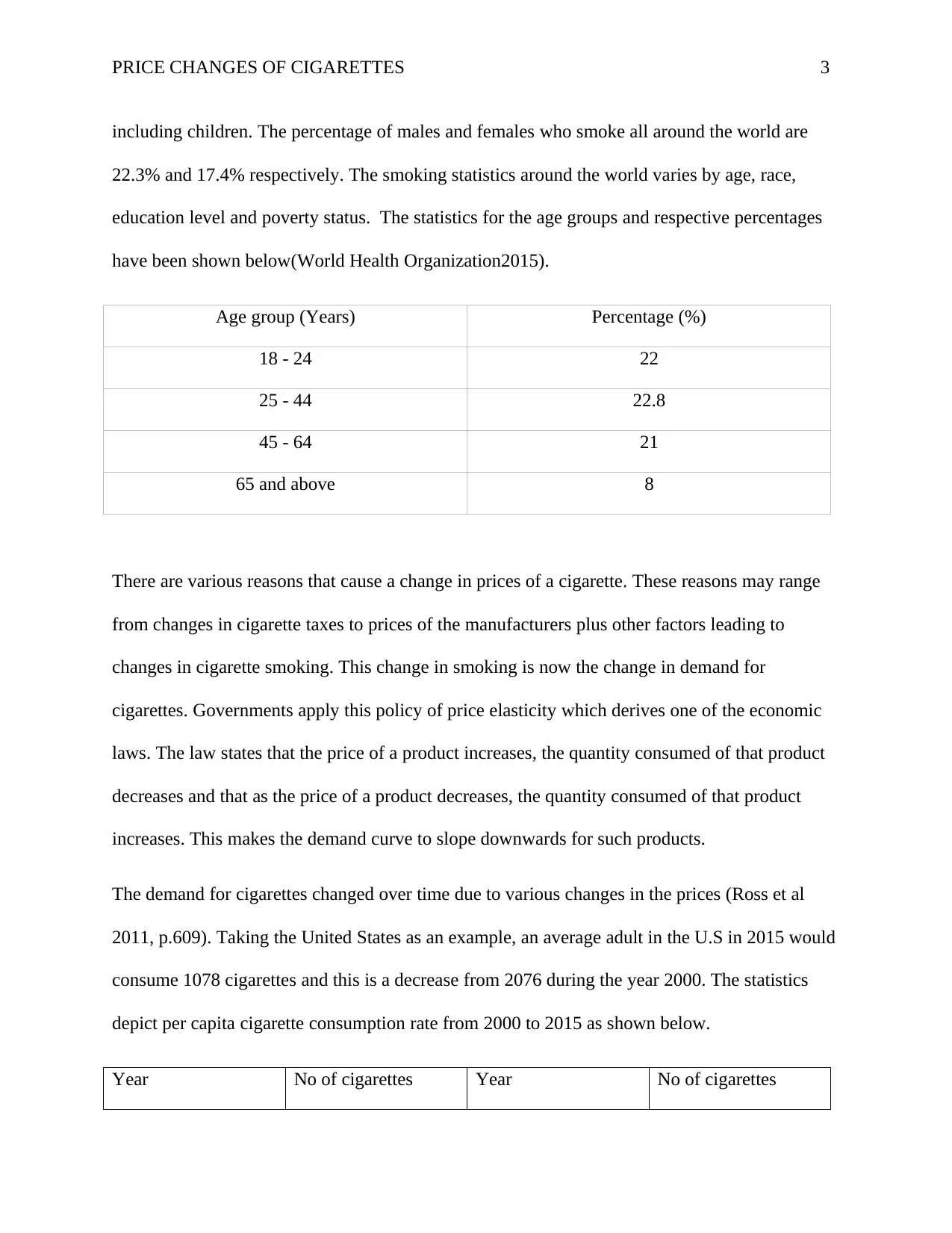
PRICE CHANGES OF CIGARETTES 3
including children. The percentage of males and females who smoke all around the world are
22.3% and 17.4% respectively. The smoking statistics around the world varies by age, race,
education level and poverty status. The statistics for the age groups and respective percentages
have been shown below(World Health Organization2015).
Age group (Years) Percentage (%)
18 - 24 22
25 - 44 22.8
45 - 64 21
65 and above 8
There are various reasons that cause a change in prices of a cigarette. These reasons may range
from changes in cigarette taxes to prices of the manufacturers plus other factors leading to
changes in cigarette smoking. This change in smoking is now the change in demand for
cigarettes. Governments apply this policy of price elasticity which derives one of the economic
laws. The law states that the price of a product increases, the quantity consumed of that product
decreases and that as the price of a product decreases, the quantity consumed of that product
increases. This makes the demand curve to slope downwards for such products.
The demand for cigarettes changed over time due to various changes in the prices (Ross et al
2011, p.609). Taking the United States as an example, an average adult in the U.S in 2015 would
consume 1078 cigarettes and this is a decrease from 2076 during the year 2000. The statistics
depict per capita cigarette consumption rate from 2000 to 2015 as shown below.
Year No of cigarettes Year No of cigarettes
including children. The percentage of males and females who smoke all around the world are
22.3% and 17.4% respectively. The smoking statistics around the world varies by age, race,
education level and poverty status. The statistics for the age groups and respective percentages
have been shown below(World Health Organization2015).
Age group (Years) Percentage (%)
18 - 24 22
25 - 44 22.8
45 - 64 21
65 and above 8
There are various reasons that cause a change in prices of a cigarette. These reasons may range
from changes in cigarette taxes to prices of the manufacturers plus other factors leading to
changes in cigarette smoking. This change in smoking is now the change in demand for
cigarettes. Governments apply this policy of price elasticity which derives one of the economic
laws. The law states that the price of a product increases, the quantity consumed of that product
decreases and that as the price of a product decreases, the quantity consumed of that product
increases. This makes the demand curve to slope downwards for such products.
The demand for cigarettes changed over time due to various changes in the prices (Ross et al
2011, p.609). Taking the United States as an example, an average adult in the U.S in 2015 would
consume 1078 cigarettes and this is a decrease from 2076 during the year 2000. The statistics
depict per capita cigarette consumption rate from 2000 to 2015 as shown below.
Year No of cigarettes Year No of cigarettes
⊘ This is a preview!⊘
Do you want full access?
Subscribe today to unlock all pages.

Trusted by 1+ million students worldwide
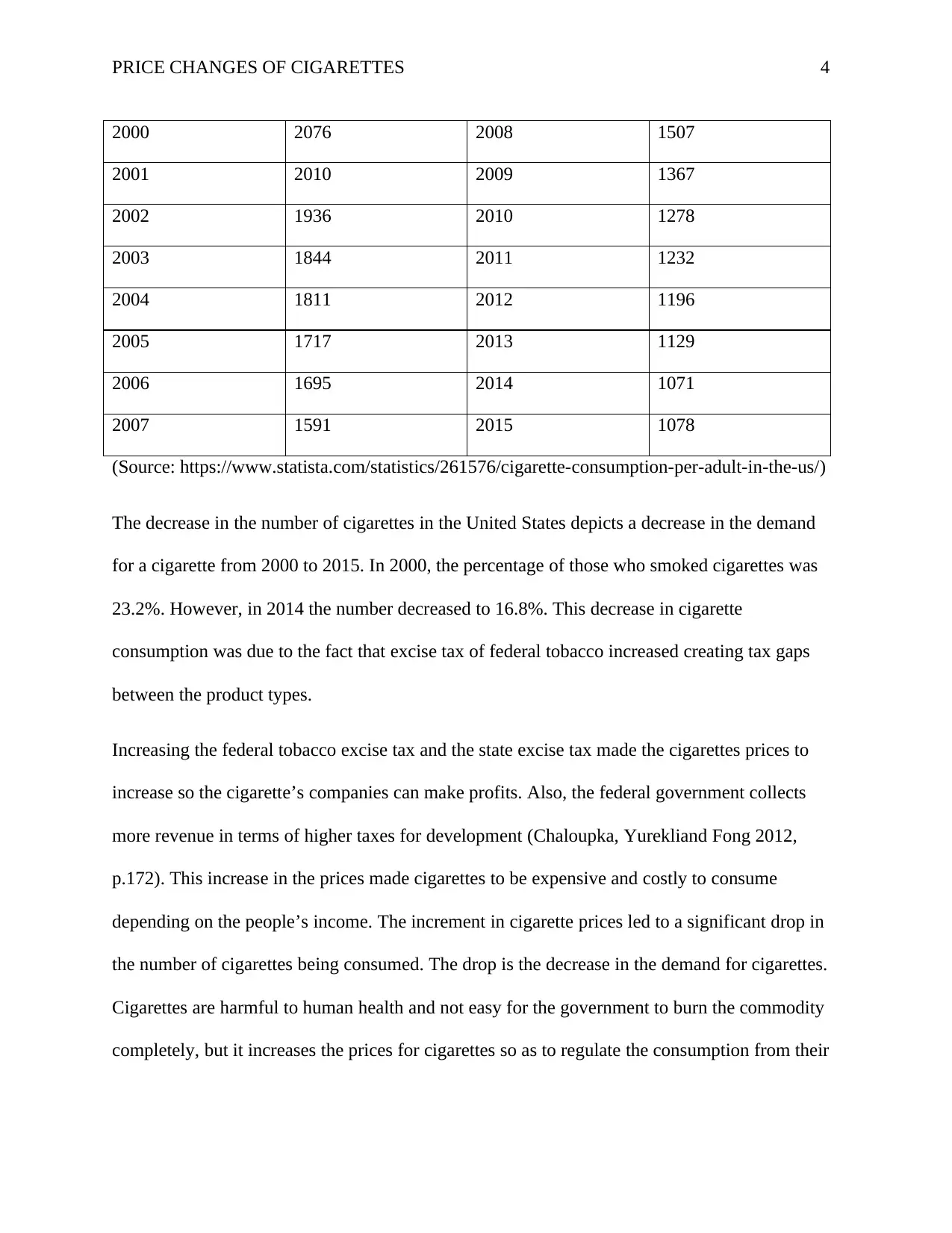
PRICE CHANGES OF CIGARETTES 4
2000 2076 2008 1507
2001 2010 2009 1367
2002 1936 2010 1278
2003 1844 2011 1232
2004 1811 2012 1196
2005 1717 2013 1129
2006 1695 2014 1071
2007 1591 2015 1078
(Source: https://www.statista.com/statistics/261576/cigarette-consumption-per-adult-in-the-us/)
The decrease in the number of cigarettes in the United States depicts a decrease in the demand
for a cigarette from 2000 to 2015. In 2000, the percentage of those who smoked cigarettes was
23.2%. However, in 2014 the number decreased to 16.8%. This decrease in cigarette
consumption was due to the fact that excise tax of federal tobacco increased creating tax gaps
between the product types.
Increasing the federal tobacco excise tax and the state excise tax made the cigarettes prices to
increase so the cigarette’s companies can make profits. Also, the federal government collects
more revenue in terms of higher taxes for development (Chaloupka, Yurekliand Fong 2012,
p.172). This increase in the prices made cigarettes to be expensive and costly to consume
depending on the people’s income. The increment in cigarette prices led to a significant drop in
the number of cigarettes being consumed. The drop is the decrease in the demand for cigarettes.
Cigarettes are harmful to human health and not easy for the government to burn the commodity
completely, but it increases the prices for cigarettes so as to regulate the consumption from their
2000 2076 2008 1507
2001 2010 2009 1367
2002 1936 2010 1278
2003 1844 2011 1232
2004 1811 2012 1196
2005 1717 2013 1129
2006 1695 2014 1071
2007 1591 2015 1078
(Source: https://www.statista.com/statistics/261576/cigarette-consumption-per-adult-in-the-us/)
The decrease in the number of cigarettes in the United States depicts a decrease in the demand
for a cigarette from 2000 to 2015. In 2000, the percentage of those who smoked cigarettes was
23.2%. However, in 2014 the number decreased to 16.8%. This decrease in cigarette
consumption was due to the fact that excise tax of federal tobacco increased creating tax gaps
between the product types.
Increasing the federal tobacco excise tax and the state excise tax made the cigarettes prices to
increase so the cigarette’s companies can make profits. Also, the federal government collects
more revenue in terms of higher taxes for development (Chaloupka, Yurekliand Fong 2012,
p.172). This increase in the prices made cigarettes to be expensive and costly to consume
depending on the people’s income. The increment in cigarette prices led to a significant drop in
the number of cigarettes being consumed. The drop is the decrease in the demand for cigarettes.
Cigarettes are harmful to human health and not easy for the government to burn the commodity
completely, but it increases the prices for cigarettes so as to regulate the consumption from their
Paraphrase This Document
Need a fresh take? Get an instant paraphrase of this document with our AI Paraphraser
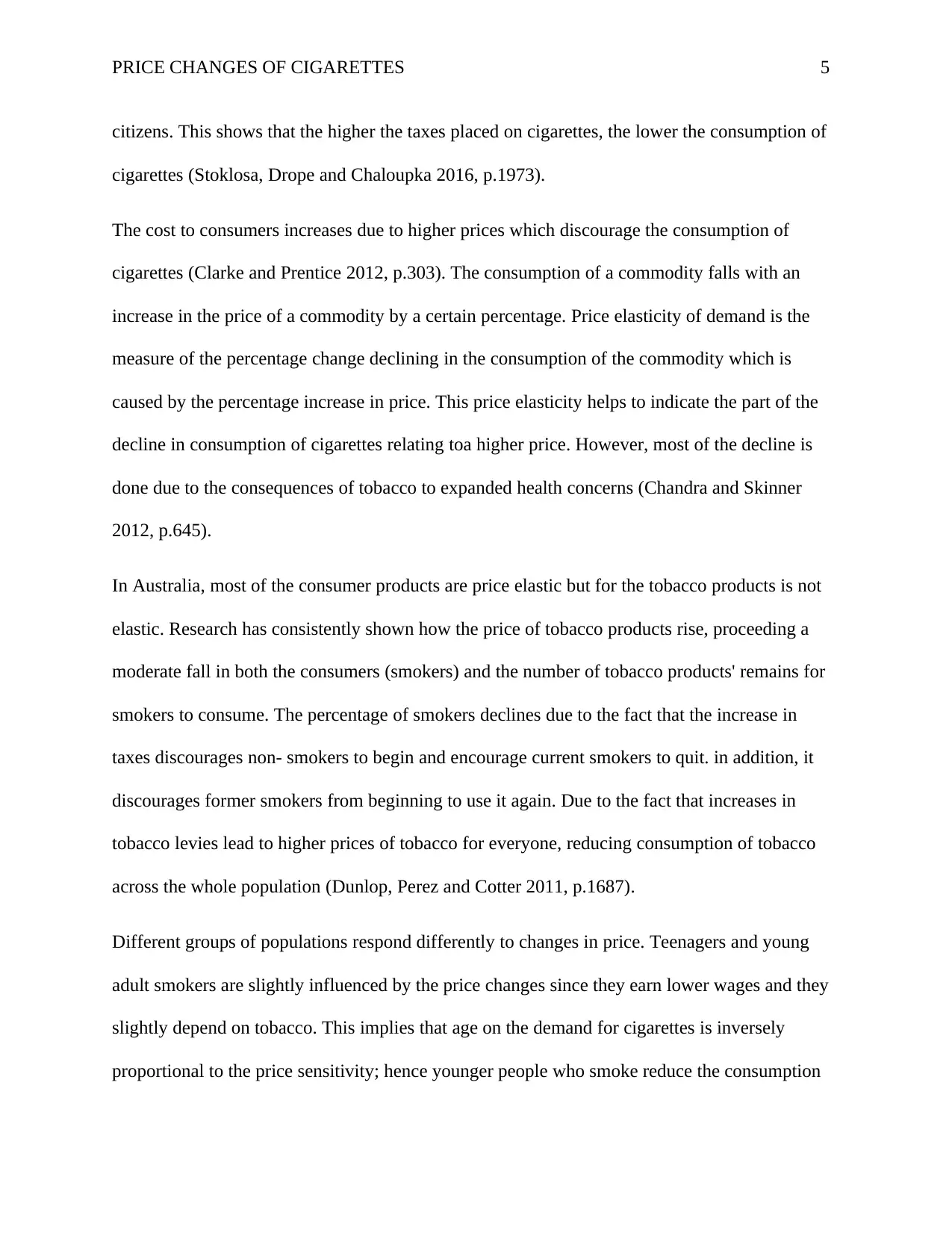
PRICE CHANGES OF CIGARETTES 5
citizens. This shows that the higher the taxes placed on cigarettes, the lower the consumption of
cigarettes (Stoklosa, Drope and Chaloupka 2016, p.1973).
The cost to consumers increases due to higher prices which discourage the consumption of
cigarettes (Clarke and Prentice 2012, p.303). The consumption of a commodity falls with an
increase in the price of a commodity by a certain percentage. Price elasticity of demand is the
measure of the percentage change declining in the consumption of the commodity which is
caused by the percentage increase in price. This price elasticity helps to indicate the part of the
decline in consumption of cigarettes relating toa higher price. However, most of the decline is
done due to the consequences of tobacco to expanded health concerns (Chandra and Skinner
2012, p.645).
In Australia, most of the consumer products are price elastic but for the tobacco products is not
elastic. Research has consistently shown how the price of tobacco products rise, proceeding a
moderate fall in both the consumers (smokers) and the number of tobacco products' remains for
smokers to consume. The percentage of smokers declines due to the fact that the increase in
taxes discourages non- smokers to begin and encourage current smokers to quit. in addition, it
discourages former smokers from beginning to use it again. Due to the fact that increases in
tobacco levies lead to higher prices of tobacco for everyone, reducing consumption of tobacco
across the whole population (Dunlop, Perez and Cotter 2011, p.1687).
Different groups of populations respond differently to changes in price. Teenagers and young
adult smokers are slightly influenced by the price changes since they earn lower wages and they
slightly depend on tobacco. This implies that age on the demand for cigarettes is inversely
proportional to the price sensitivity; hence younger people who smoke reduce the consumption
citizens. This shows that the higher the taxes placed on cigarettes, the lower the consumption of
cigarettes (Stoklosa, Drope and Chaloupka 2016, p.1973).
The cost to consumers increases due to higher prices which discourage the consumption of
cigarettes (Clarke and Prentice 2012, p.303). The consumption of a commodity falls with an
increase in the price of a commodity by a certain percentage. Price elasticity of demand is the
measure of the percentage change declining in the consumption of the commodity which is
caused by the percentage increase in price. This price elasticity helps to indicate the part of the
decline in consumption of cigarettes relating toa higher price. However, most of the decline is
done due to the consequences of tobacco to expanded health concerns (Chandra and Skinner
2012, p.645).
In Australia, most of the consumer products are price elastic but for the tobacco products is not
elastic. Research has consistently shown how the price of tobacco products rise, proceeding a
moderate fall in both the consumers (smokers) and the number of tobacco products' remains for
smokers to consume. The percentage of smokers declines due to the fact that the increase in
taxes discourages non- smokers to begin and encourage current smokers to quit. in addition, it
discourages former smokers from beginning to use it again. Due to the fact that increases in
tobacco levies lead to higher prices of tobacco for everyone, reducing consumption of tobacco
across the whole population (Dunlop, Perez and Cotter 2011, p.1687).
Different groups of populations respond differently to changes in price. Teenagers and young
adult smokers are slightly influenced by the price changes since they earn lower wages and they
slightly depend on tobacco. This implies that age on the demand for cigarettes is inversely
proportional to the price sensitivity; hence younger people who smoke reduce the consumption
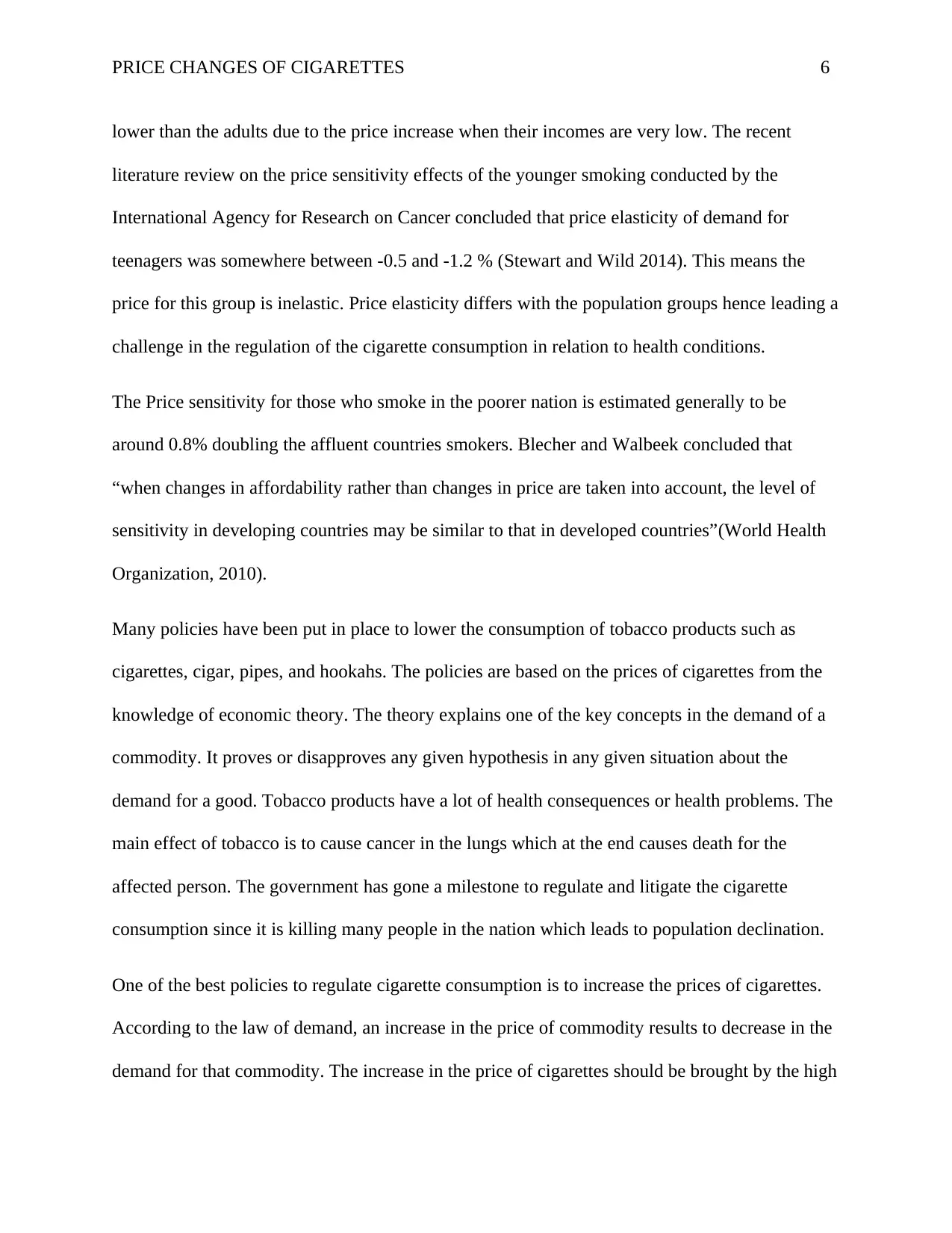
PRICE CHANGES OF CIGARETTES 6
lower than the adults due to the price increase when their incomes are very low. The recent
literature review on the price sensitivity effects of the younger smoking conducted by the
International Agency for Research on Cancer concluded that price elasticity of demand for
teenagers was somewhere between -0.5 and -1.2 % (Stewart and Wild 2014). This means the
price for this group is inelastic. Price elasticity differs with the population groups hence leading a
challenge in the regulation of the cigarette consumption in relation to health conditions.
The Price sensitivity for those who smoke in the poorer nation is estimated generally to be
around 0.8% doubling the affluent countries smokers. Blecher and Walbeek concluded that
“when changes in affordability rather than changes in price are taken into account, the level of
sensitivity in developing countries may be similar to that in developed countries”(World Health
Organization, 2010).
Many policies have been put in place to lower the consumption of tobacco products such as
cigarettes, cigar, pipes, and hookahs. The policies are based on the prices of cigarettes from the
knowledge of economic theory. The theory explains one of the key concepts in the demand of a
commodity. It proves or disapproves any given hypothesis in any given situation about the
demand for a good. Tobacco products have a lot of health consequences or health problems. The
main effect of tobacco is to cause cancer in the lungs which at the end causes death for the
affected person. The government has gone a milestone to regulate and litigate the cigarette
consumption since it is killing many people in the nation which leads to population declination.
One of the best policies to regulate cigarette consumption is to increase the prices of cigarettes.
According to the law of demand, an increase in the price of commodity results to decrease in the
demand for that commodity. The increase in the price of cigarettes should be brought by the high
lower than the adults due to the price increase when their incomes are very low. The recent
literature review on the price sensitivity effects of the younger smoking conducted by the
International Agency for Research on Cancer concluded that price elasticity of demand for
teenagers was somewhere between -0.5 and -1.2 % (Stewart and Wild 2014). This means the
price for this group is inelastic. Price elasticity differs with the population groups hence leading a
challenge in the regulation of the cigarette consumption in relation to health conditions.
The Price sensitivity for those who smoke in the poorer nation is estimated generally to be
around 0.8% doubling the affluent countries smokers. Blecher and Walbeek concluded that
“when changes in affordability rather than changes in price are taken into account, the level of
sensitivity in developing countries may be similar to that in developed countries”(World Health
Organization, 2010).
Many policies have been put in place to lower the consumption of tobacco products such as
cigarettes, cigar, pipes, and hookahs. The policies are based on the prices of cigarettes from the
knowledge of economic theory. The theory explains one of the key concepts in the demand of a
commodity. It proves or disapproves any given hypothesis in any given situation about the
demand for a good. Tobacco products have a lot of health consequences or health problems. The
main effect of tobacco is to cause cancer in the lungs which at the end causes death for the
affected person. The government has gone a milestone to regulate and litigate the cigarette
consumption since it is killing many people in the nation which leads to population declination.
One of the best policies to regulate cigarette consumption is to increase the prices of cigarettes.
According to the law of demand, an increase in the price of commodity results to decrease in the
demand for that commodity. The increase in the price of cigarettes should be brought by the high
⊘ This is a preview!⊘
Do you want full access?
Subscribe today to unlock all pages.

Trusted by 1+ million students worldwide
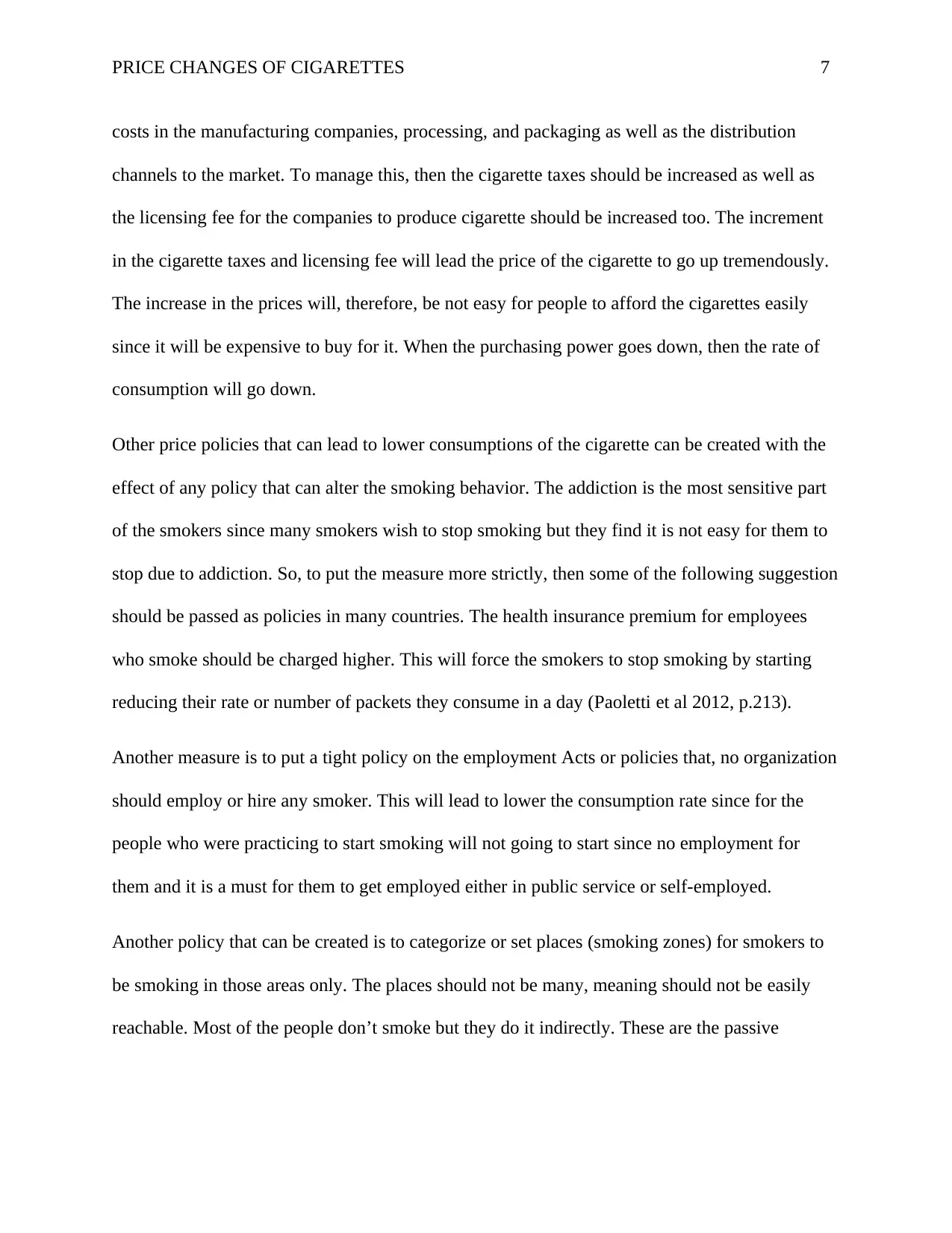
PRICE CHANGES OF CIGARETTES 7
costs in the manufacturing companies, processing, and packaging as well as the distribution
channels to the market. To manage this, then the cigarette taxes should be increased as well as
the licensing fee for the companies to produce cigarette should be increased too. The increment
in the cigarette taxes and licensing fee will lead the price of the cigarette to go up tremendously.
The increase in the prices will, therefore, be not easy for people to afford the cigarettes easily
since it will be expensive to buy for it. When the purchasing power goes down, then the rate of
consumption will go down.
Other price policies that can lead to lower consumptions of the cigarette can be created with the
effect of any policy that can alter the smoking behavior. The addiction is the most sensitive part
of the smokers since many smokers wish to stop smoking but they find it is not easy for them to
stop due to addiction. So, to put the measure more strictly, then some of the following suggestion
should be passed as policies in many countries. The health insurance premium for employees
who smoke should be charged higher. This will force the smokers to stop smoking by starting
reducing their rate or number of packets they consume in a day (Paoletti et al 2012, p.213).
Another measure is to put a tight policy on the employment Acts or policies that, no organization
should employ or hire any smoker. This will lead to lower the consumption rate since for the
people who were practicing to start smoking will not going to start since no employment for
them and it is a must for them to get employed either in public service or self-employed.
Another policy that can be created is to categorize or set places (smoking zones) for smokers to
be smoking in those areas only. The places should not be many, meaning should not be easily
reachable. Most of the people don’t smoke but they do it indirectly. These are the passive
costs in the manufacturing companies, processing, and packaging as well as the distribution
channels to the market. To manage this, then the cigarette taxes should be increased as well as
the licensing fee for the companies to produce cigarette should be increased too. The increment
in the cigarette taxes and licensing fee will lead the price of the cigarette to go up tremendously.
The increase in the prices will, therefore, be not easy for people to afford the cigarettes easily
since it will be expensive to buy for it. When the purchasing power goes down, then the rate of
consumption will go down.
Other price policies that can lead to lower consumptions of the cigarette can be created with the
effect of any policy that can alter the smoking behavior. The addiction is the most sensitive part
of the smokers since many smokers wish to stop smoking but they find it is not easy for them to
stop due to addiction. So, to put the measure more strictly, then some of the following suggestion
should be passed as policies in many countries. The health insurance premium for employees
who smoke should be charged higher. This will force the smokers to stop smoking by starting
reducing their rate or number of packets they consume in a day (Paoletti et al 2012, p.213).
Another measure is to put a tight policy on the employment Acts or policies that, no organization
should employ or hire any smoker. This will lead to lower the consumption rate since for the
people who were practicing to start smoking will not going to start since no employment for
them and it is a must for them to get employed either in public service or self-employed.
Another policy that can be created is to categorize or set places (smoking zones) for smokers to
be smoking in those areas only. The places should not be many, meaning should not be easily
reachable. Most of the people don’t smoke but they do it indirectly. These are the passive
Paraphrase This Document
Need a fresh take? Get an instant paraphrase of this document with our AI Paraphraser
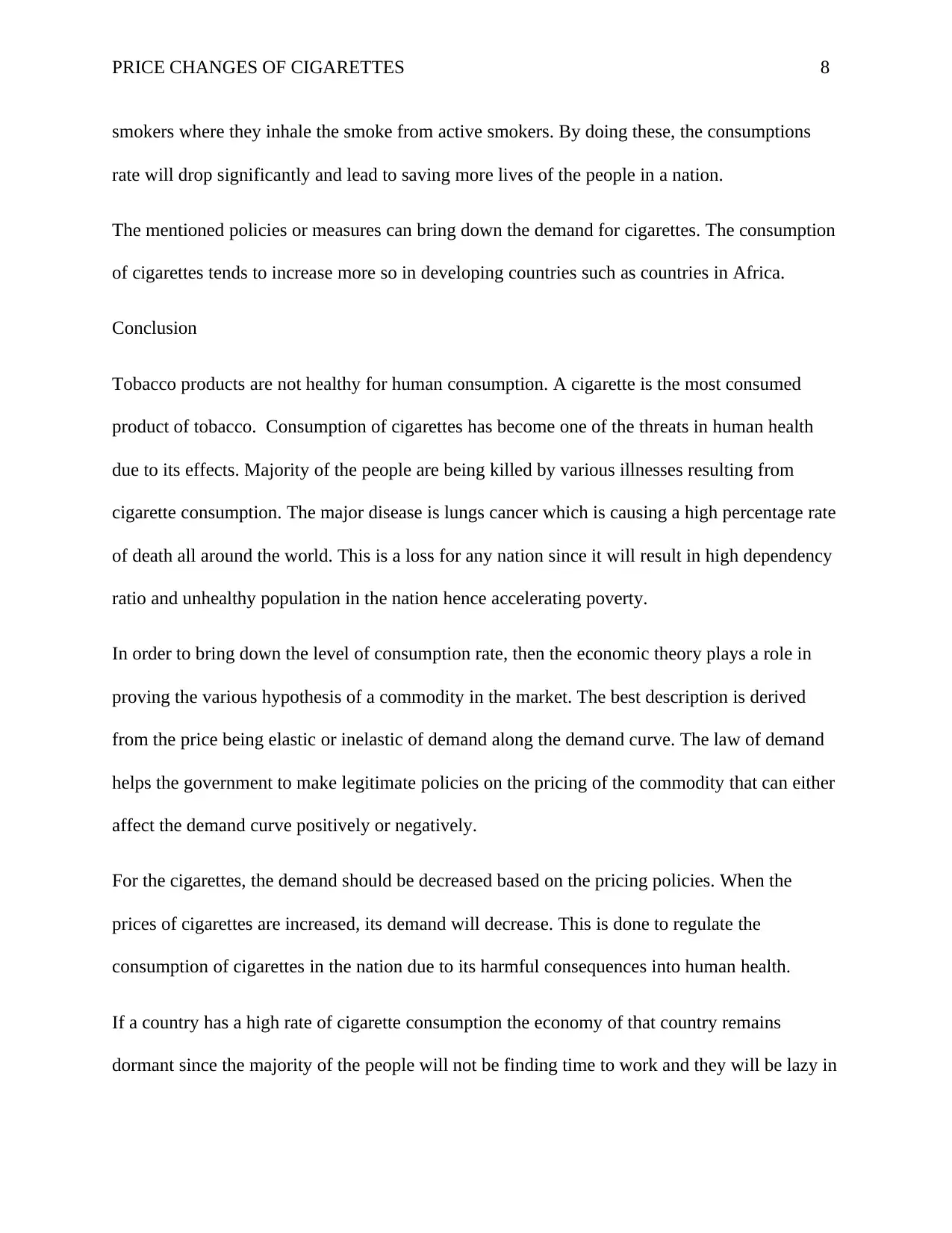
PRICE CHANGES OF CIGARETTES 8
smokers where they inhale the smoke from active smokers. By doing these, the consumptions
rate will drop significantly and lead to saving more lives of the people in a nation.
The mentioned policies or measures can bring down the demand for cigarettes. The consumption
of cigarettes tends to increase more so in developing countries such as countries in Africa.
Conclusion
Tobacco products are not healthy for human consumption. A cigarette is the most consumed
product of tobacco. Consumption of cigarettes has become one of the threats in human health
due to its effects. Majority of the people are being killed by various illnesses resulting from
cigarette consumption. The major disease is lungs cancer which is causing a high percentage rate
of death all around the world. This is a loss for any nation since it will result in high dependency
ratio and unhealthy population in the nation hence accelerating poverty.
In order to bring down the level of consumption rate, then the economic theory plays a role in
proving the various hypothesis of a commodity in the market. The best description is derived
from the price being elastic or inelastic of demand along the demand curve. The law of demand
helps the government to make legitimate policies on the pricing of the commodity that can either
affect the demand curve positively or negatively.
For the cigarettes, the demand should be decreased based on the pricing policies. When the
prices of cigarettes are increased, its demand will decrease. This is done to regulate the
consumption of cigarettes in the nation due to its harmful consequences into human health.
If a country has a high rate of cigarette consumption the economy of that country remains
dormant since the majority of the people will not be finding time to work and they will be lazy in
smokers where they inhale the smoke from active smokers. By doing these, the consumptions
rate will drop significantly and lead to saving more lives of the people in a nation.
The mentioned policies or measures can bring down the demand for cigarettes. The consumption
of cigarettes tends to increase more so in developing countries such as countries in Africa.
Conclusion
Tobacco products are not healthy for human consumption. A cigarette is the most consumed
product of tobacco. Consumption of cigarettes has become one of the threats in human health
due to its effects. Majority of the people are being killed by various illnesses resulting from
cigarette consumption. The major disease is lungs cancer which is causing a high percentage rate
of death all around the world. This is a loss for any nation since it will result in high dependency
ratio and unhealthy population in the nation hence accelerating poverty.
In order to bring down the level of consumption rate, then the economic theory plays a role in
proving the various hypothesis of a commodity in the market. The best description is derived
from the price being elastic or inelastic of demand along the demand curve. The law of demand
helps the government to make legitimate policies on the pricing of the commodity that can either
affect the demand curve positively or negatively.
For the cigarettes, the demand should be decreased based on the pricing policies. When the
prices of cigarettes are increased, its demand will decrease. This is done to regulate the
consumption of cigarettes in the nation due to its harmful consequences into human health.
If a country has a high rate of cigarette consumption the economy of that country remains
dormant since the majority of the people will not be finding time to work and they will be lazy in
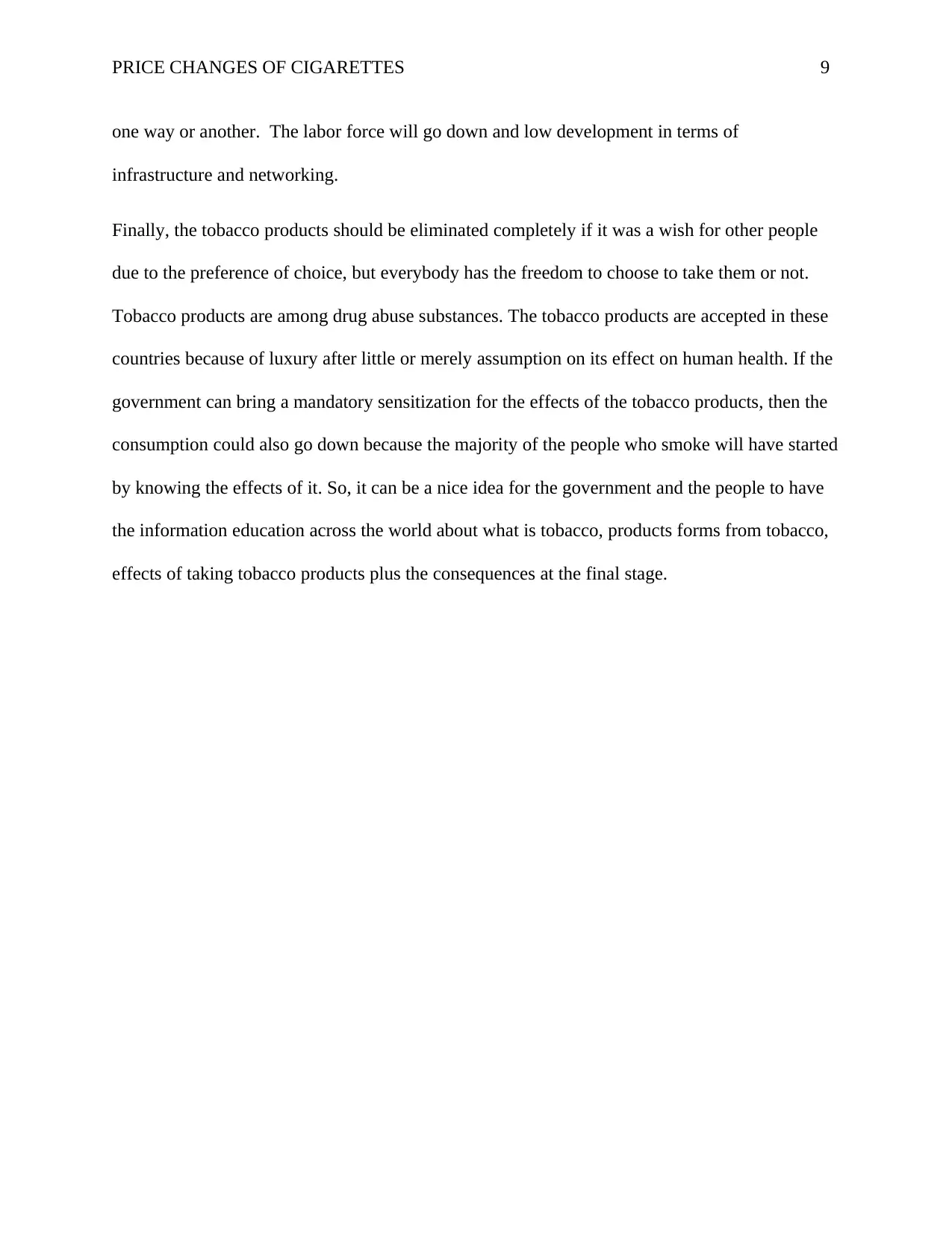
PRICE CHANGES OF CIGARETTES 9
one way or another. The labor force will go down and low development in terms of
infrastructure and networking.
Finally, the tobacco products should be eliminated completely if it was a wish for other people
due to the preference of choice, but everybody has the freedom to choose to take them or not.
Tobacco products are among drug abuse substances. The tobacco products are accepted in these
countries because of luxury after little or merely assumption on its effect on human health. If the
government can bring a mandatory sensitization for the effects of the tobacco products, then the
consumption could also go down because the majority of the people who smoke will have started
by knowing the effects of it. So, it can be a nice idea for the government and the people to have
the information education across the world about what is tobacco, products forms from tobacco,
effects of taking tobacco products plus the consequences at the final stage.
one way or another. The labor force will go down and low development in terms of
infrastructure and networking.
Finally, the tobacco products should be eliminated completely if it was a wish for other people
due to the preference of choice, but everybody has the freedom to choose to take them or not.
Tobacco products are among drug abuse substances. The tobacco products are accepted in these
countries because of luxury after little or merely assumption on its effect on human health. If the
government can bring a mandatory sensitization for the effects of the tobacco products, then the
consumption could also go down because the majority of the people who smoke will have started
by knowing the effects of it. So, it can be a nice idea for the government and the people to have
the information education across the world about what is tobacco, products forms from tobacco,
effects of taking tobacco products plus the consequences at the final stage.
⊘ This is a preview!⊘
Do you want full access?
Subscribe today to unlock all pages.

Trusted by 1+ million students worldwide
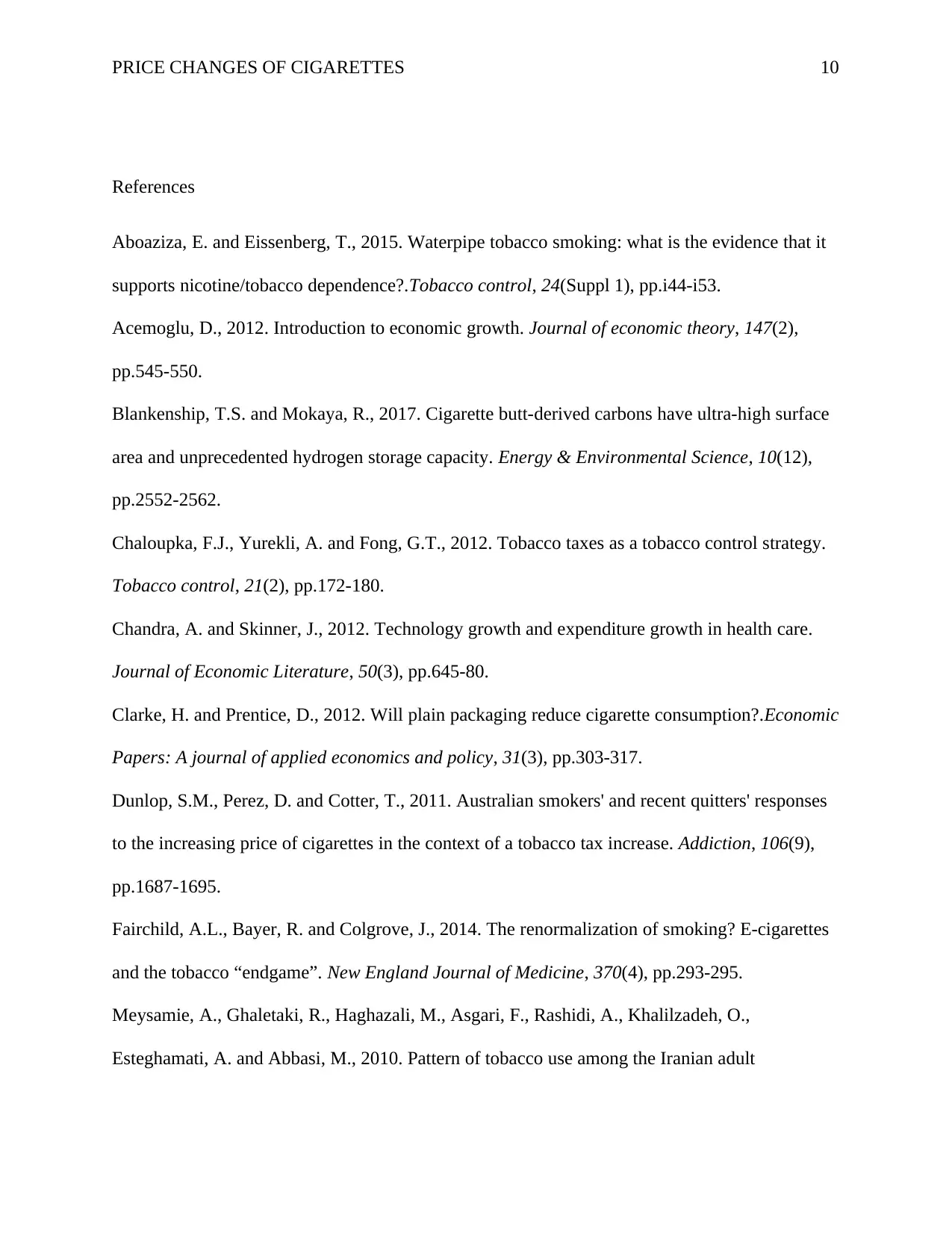
PRICE CHANGES OF CIGARETTES 10
References
Aboaziza, E. and Eissenberg, T., 2015. Waterpipe tobacco smoking: what is the evidence that it
supports nicotine/tobacco dependence?.Tobacco control, 24(Suppl 1), pp.i44-i53.
Acemoglu, D., 2012. Introduction to economic growth. Journal of economic theory, 147(2),
pp.545-550.
Blankenship, T.S. and Mokaya, R., 2017. Cigarette butt-derived carbons have ultra-high surface
area and unprecedented hydrogen storage capacity. Energy & Environmental Science, 10(12),
pp.2552-2562.
Chaloupka, F.J., Yurekli, A. and Fong, G.T., 2012. Tobacco taxes as a tobacco control strategy.
Tobacco control, 21(2), pp.172-180.
Chandra, A. and Skinner, J., 2012. Technology growth and expenditure growth in health care.
Journal of Economic Literature, 50(3), pp.645-80.
Clarke, H. and Prentice, D., 2012. Will plain packaging reduce cigarette consumption?.Economic
Papers: A journal of applied economics and policy, 31(3), pp.303-317.
Dunlop, S.M., Perez, D. and Cotter, T., 2011. Australian smokers' and recent quitters' responses
to the increasing price of cigarettes in the context of a tobacco tax increase. Addiction, 106(9),
pp.1687-1695.
Fairchild, A.L., Bayer, R. and Colgrove, J., 2014. The renormalization of smoking? E-cigarettes
and the tobacco “endgame”. New England Journal of Medicine, 370(4), pp.293-295.
Meysamie, A., Ghaletaki, R., Haghazali, M., Asgari, F., Rashidi, A., Khalilzadeh, O.,
Esteghamati, A. and Abbasi, M., 2010. Pattern of tobacco use among the Iranian adult
References
Aboaziza, E. and Eissenberg, T., 2015. Waterpipe tobacco smoking: what is the evidence that it
supports nicotine/tobacco dependence?.Tobacco control, 24(Suppl 1), pp.i44-i53.
Acemoglu, D., 2012. Introduction to economic growth. Journal of economic theory, 147(2),
pp.545-550.
Blankenship, T.S. and Mokaya, R., 2017. Cigarette butt-derived carbons have ultra-high surface
area and unprecedented hydrogen storage capacity. Energy & Environmental Science, 10(12),
pp.2552-2562.
Chaloupka, F.J., Yurekli, A. and Fong, G.T., 2012. Tobacco taxes as a tobacco control strategy.
Tobacco control, 21(2), pp.172-180.
Chandra, A. and Skinner, J., 2012. Technology growth and expenditure growth in health care.
Journal of Economic Literature, 50(3), pp.645-80.
Clarke, H. and Prentice, D., 2012. Will plain packaging reduce cigarette consumption?.Economic
Papers: A journal of applied economics and policy, 31(3), pp.303-317.
Dunlop, S.M., Perez, D. and Cotter, T., 2011. Australian smokers' and recent quitters' responses
to the increasing price of cigarettes in the context of a tobacco tax increase. Addiction, 106(9),
pp.1687-1695.
Fairchild, A.L., Bayer, R. and Colgrove, J., 2014. The renormalization of smoking? E-cigarettes
and the tobacco “endgame”. New England Journal of Medicine, 370(4), pp.293-295.
Meysamie, A., Ghaletaki, R., Haghazali, M., Asgari, F., Rashidi, A., Khalilzadeh, O.,
Esteghamati, A. and Abbasi, M., 2010. Pattern of tobacco use among the Iranian adult
Paraphrase This Document
Need a fresh take? Get an instant paraphrase of this document with our AI Paraphraser
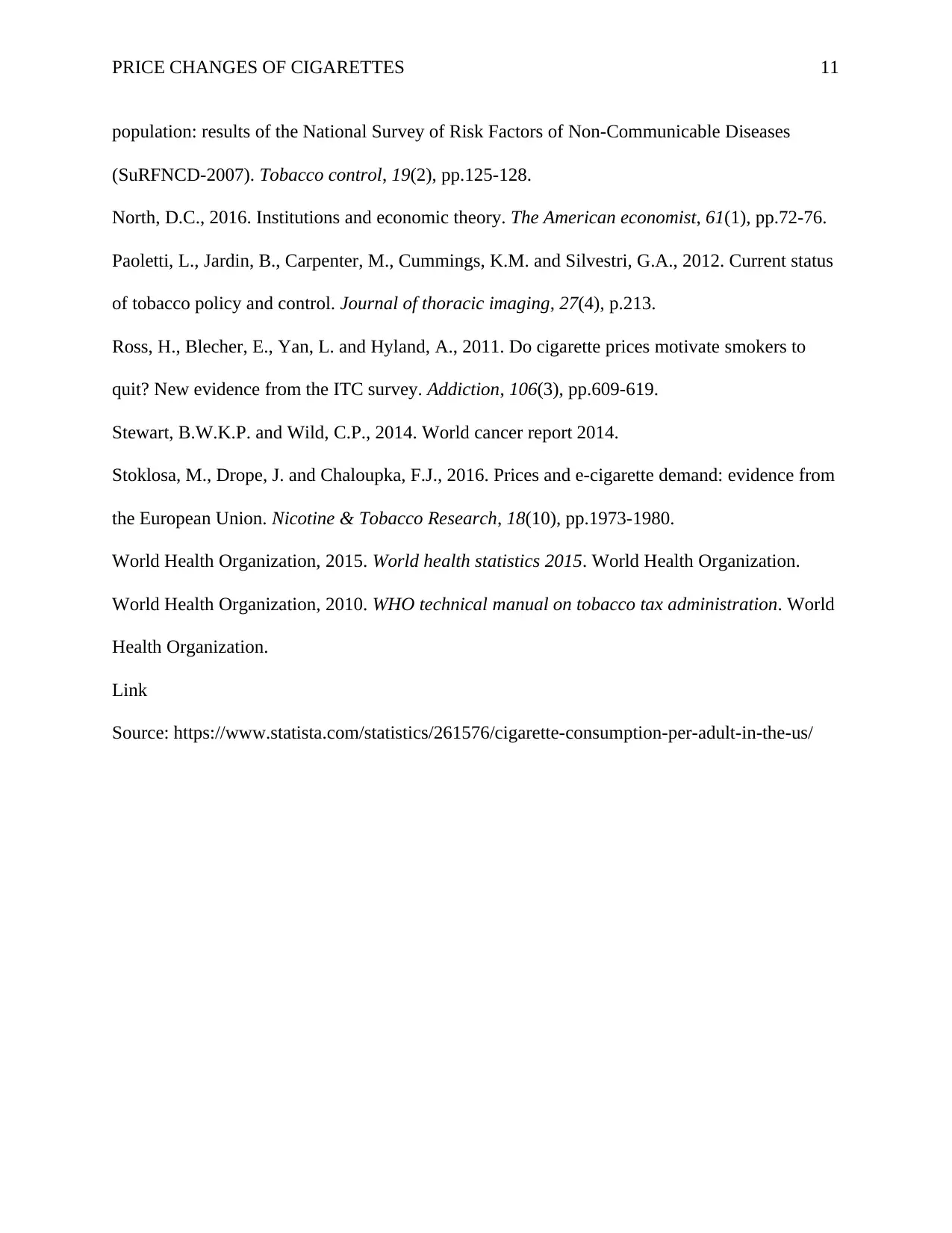
PRICE CHANGES OF CIGARETTES 11
population: results of the National Survey of Risk Factors of Non-Communicable Diseases
(SuRFNCD-2007). Tobacco control, 19(2), pp.125-128.
North, D.C., 2016. Institutions and economic theory. The American economist, 61(1), pp.72-76.
Paoletti, L., Jardin, B., Carpenter, M., Cummings, K.M. and Silvestri, G.A., 2012. Current status
of tobacco policy and control. Journal of thoracic imaging, 27(4), p.213.
Ross, H., Blecher, E., Yan, L. and Hyland, A., 2011. Do cigarette prices motivate smokers to
quit? New evidence from the ITC survey. Addiction, 106(3), pp.609-619.
Stewart, B.W.K.P. and Wild, C.P., 2014. World cancer report 2014.
Stoklosa, M., Drope, J. and Chaloupka, F.J., 2016. Prices and e-cigarette demand: evidence from
the European Union. Nicotine & Tobacco Research, 18(10), pp.1973-1980.
World Health Organization, 2015. World health statistics 2015. World Health Organization.
World Health Organization, 2010. WHO technical manual on tobacco tax administration. World
Health Organization.
Link
Source: https://www.statista.com/statistics/261576/cigarette-consumption-per-adult-in-the-us/
population: results of the National Survey of Risk Factors of Non-Communicable Diseases
(SuRFNCD-2007). Tobacco control, 19(2), pp.125-128.
North, D.C., 2016. Institutions and economic theory. The American economist, 61(1), pp.72-76.
Paoletti, L., Jardin, B., Carpenter, M., Cummings, K.M. and Silvestri, G.A., 2012. Current status
of tobacco policy and control. Journal of thoracic imaging, 27(4), p.213.
Ross, H., Blecher, E., Yan, L. and Hyland, A., 2011. Do cigarette prices motivate smokers to
quit? New evidence from the ITC survey. Addiction, 106(3), pp.609-619.
Stewart, B.W.K.P. and Wild, C.P., 2014. World cancer report 2014.
Stoklosa, M., Drope, J. and Chaloupka, F.J., 2016. Prices and e-cigarette demand: evidence from
the European Union. Nicotine & Tobacco Research, 18(10), pp.1973-1980.
World Health Organization, 2015. World health statistics 2015. World Health Organization.
World Health Organization, 2010. WHO technical manual on tobacco tax administration. World
Health Organization.
Link
Source: https://www.statista.com/statistics/261576/cigarette-consumption-per-adult-in-the-us/
1 out of 11
Related Documents
Your All-in-One AI-Powered Toolkit for Academic Success.
+13062052269
info@desklib.com
Available 24*7 on WhatsApp / Email
![[object Object]](/_next/static/media/star-bottom.7253800d.svg)
Unlock your academic potential
Copyright © 2020–2025 A2Z Services. All Rights Reserved. Developed and managed by ZUCOL.




